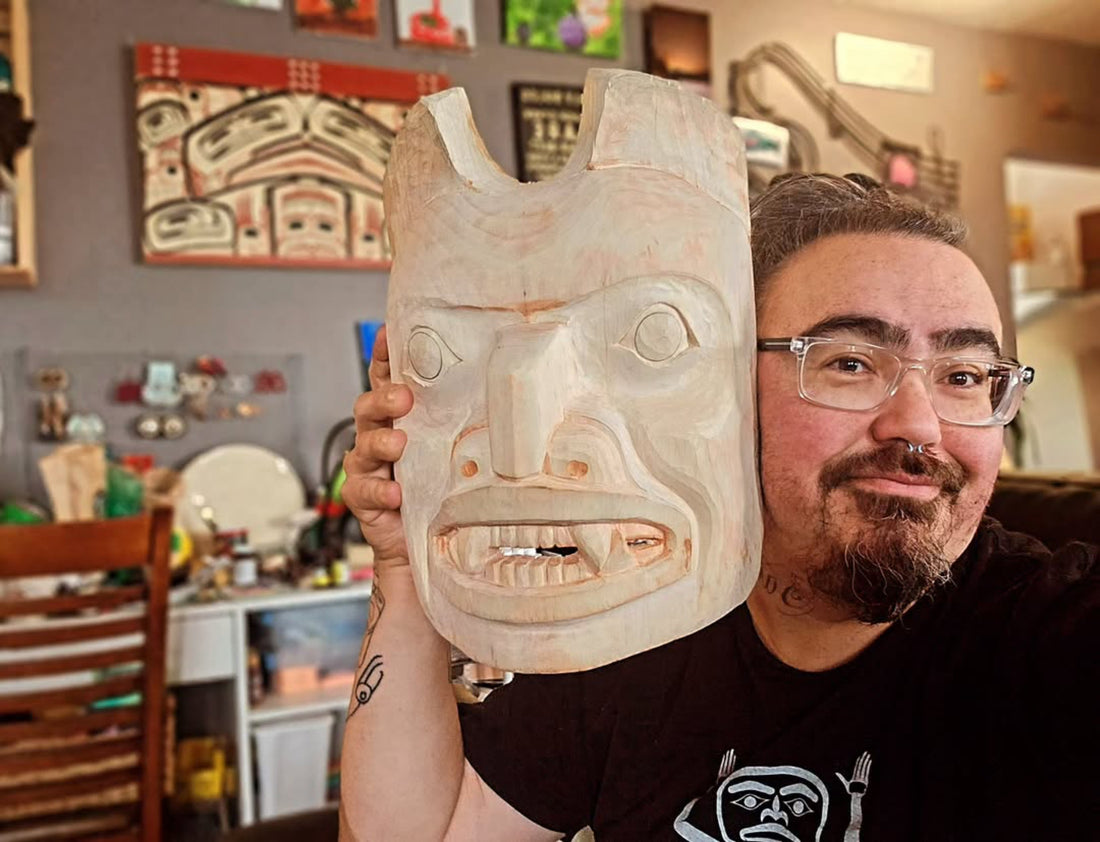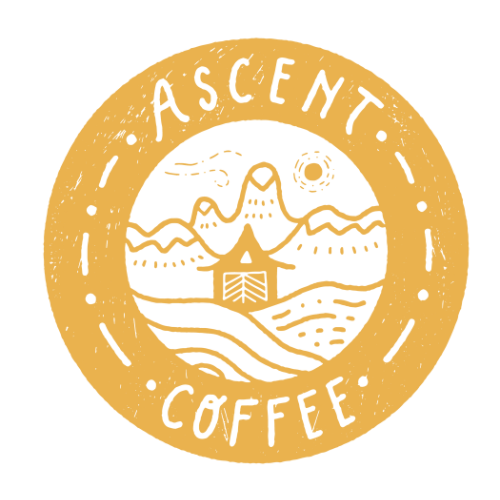
Artist Rob Davis: We’re Still Here
Share
Rob Davis sits smiling in a cozy, art-filled studio, surrounded by vibrant, hand-painted canvases that climb the wall behind him. His hair is tied in a high bun, and he wears bold, colorful earrings that echo the visual energy of the space. His dark green Teenage Mutant Ninja Turtle parody T-shirt declares in large block letters: “YOU ARE ON NATIVE LAND.”
The room hums with personality—shelves packed with art supplies, a warm light spilling in from the next room, and artwork that speaks of land, spirit, and story. It’s a space where laughter, resistance, and cultural pride live side by side.
As he brushes a ninth coat of white paint onto a new drum design, Rob, a member of the Nisga’a Nation, reflects on cultural reclamation as a central part of his creative process.
“People say we only have an oral history, but we had a written language—and it was our art,” he says. “Every piece we make tells a story.”

Before delving into the art of his people, Rob knew he had to first learn the stories—to spend time in nature, observing how things move and shift with the seasons. Like hunting, potlatching, or speaking with elders, he understood that presence was essential. You have to be there: to hear the stories firsthand, to dance in the regalia and feel how it moves, to experience the culture in motion. What he came to realize is that art doesn’t begin with the brush or the carving tool—it begins with life. Long before he stepped into his studio, Rob was already gathering what he needed: moments of listening, watching, and moving through the world with curiosity. His life has been a quiet, steady act of collecting experiences—each one a thread—and now he’s weaving them into his art.

Born in Vancouver, Rob moved to the Nass Valley, his ancestral homeland, in his early teens. Graduating from high school there, he turned down a scholarship to the Emily Carr University of Art and Design, feeling it necessary to pursue a more practical path in carpentry instead.
It was through his apprenticeship that he returned to Vancouver’s lower mainland and worked as a roofer, a physically demanding job performed at great heights while exposed to the elements, for the next ten years.
“One morning—I’d worn my harness that day because the safety inspector was onsite—I slipped on the morning dew and fell off the roof,” says Rob. “I was dangling over the Barnet Highway for about 40 minutes until somebody finally heard me and they pulled me up.”
On the spot, Rob told his boss he was done. He thought he’d take some time off, but life continued to flow in new directions. Meeting a friend for coffee at Tim Hortons that night, he filled out a job application “for fun” and was hired the next day as a baker. For the next few years, he worked alongside a co-worker who was an avid mountain biker and introduced Rob to the sport.
When Tim Hortons phased out in-house bakers, Rob shifted gears again and joined The Bike Doctor—Vancouver’s oldest independent bike shop until its closure in 2017. He began on the sales floor but quickly moved into mechanics, learning the trade hands-on as he wrenched alongside seasoned technicians.
Rob returned to Terrace when he became a parent and took on a management role at a local bike shop. Over the next two decades, he built a deep well of industry experience before eventually striking out on his own.
“I had this idea to start my own bike shop because there was only one in Terrace,” he says. “Then my wife suggested instead of getting loans, we do it in the garage."
 Art by Erica Davis.
Art by Erica Davis.
With $5,000 in his pocket, Rob transformed their carport with walls and oversized barn doors, turning it into a bike shop they named R.E.D. Cycles—after their initials, Rob and Erica Davis. Tucked into a residential neighborhood, the unconventional storefront felt more like dropping by a friend’s place for help than visiting a typical retail shop. That down-to-earth vibe captured the grassroots spirit that resonated with local riders.
The business took off, more than doubling Rob’s initial investment in its first year. His model was simple but smart: customers preordered bikes, allowing him to avoid the risk and cost of stocking inventory that might not sell.

Then COVID hit—and suddenly, bikes were impossible to find. For the first time since opening R.E.D. Cycles, Rob had to place a booking: a commitment to order a set number of bikes from the manufacturer in advance. The first round went well—he sold most of the bikes—so he placed a second, then a third.
But by the time of the third booking, the pandemic had fully ramped up. Rob had already pre-sold every bike, but the shipment never arrived. He refunded all his customers, but he couldn’t cancel the order, leaving him on the hook for $95,000 should the bikes ever show up.
“I lost all my money paying people back for the bikes that I’d presold,” he says.
During the pandemic, Rob and Erica deepened their connection to their culture.
“We started drumming and ended up joining our local Nisga'a dance group,” says Rob.

The experience reignited Rob’s creativity. He began sharing his artwork on Instagram, which caught the attention of accomplished Wet’suwet’en artist and instructor Stephanie Anderson. She encouraged Rob to apply to the Freda Diesing School of Northwest Coast Art—a two-year program at Coast Mountain College dedicated to traditional Pacific Northwest Coast Indigenous art.
Rob started school in September 2022. One day in October, he came home to find crates of bikes sitting in the snow in his driveway—the long-delayed shipment had finally arrived, twenty months after he’d placed the order. Bound by contract, he had no choice but to accept them. Standing there in disbelief, Rob wasn’t sure what to do next.
“I brought them all inside and then just went back to focusing on school and dealt with the creditors for the whole school year,” he says.
During summer break, Rob assembled all the bikes, but only managed to sell two. His heart just wasn’t in it anymore. After returning to school and completing the carving portion of the program, he knew without a doubt that he’d moved on from the bike industry. He wanted to focus on art and jewelry making, and he began accepting painting commissions.
It was an exhausting chapter—three of their four kids were home, the bike shop was winding down, and cultural responsibilities demanded his time. But interest in his work grew quickly. While still in school, he managed to pay off nearly half of what he owed for the bikes, and has since cleared the debt entirely.

It’s easy to see why Rob’s artwork resonates so strongly. Each piece—whether it’s the bold, fluid lines of his paintings, the expressive depth of his carvings, or the grounded strength of his handcrafted jewelry—carries a deep commitment to culture and identity. His work is more than visually striking; it’s a living expression of heritage. Through every brushstroke, carved line, and metal detail, Rob honors his ancestors, the land, and the stories that have shaped him. His art both celebrates and preserves culture, bridging tradition with the present.
Rob describes his work as traditional in style, built on formline—the distinctive flowing shapes and structures at the heart of Northwest Coast art. But formline is more than a visual language; it’s a system of storytelling, identity, and cultural continuity passed down through generations.
“Form line has rules, and part of the fun is finding how you can bend those rules,” he says.

Historically, Northwest Coast art was evolving along a distinct path—but that progression was abruptly interrupted when colonizers arrived in the Nass Valley in the early 19th century. Their arrival disrupted centuries of rich cultural tradition and self-governance among the Nisga’a people. European traders and settlers brought disease, enforced religious conversion, and imposed foreign systems of governance. The residential school system aimed to erase Indigenous languages and cultural practices, while colonial land policies disregarded the Nisga’a Nation’s deep-rooted connection to their territory.
Despite these efforts to displace and assimilate them, the Nisga’a resisted—and held onto their identity. Today, Rob and his peers are picking up the threads, working to carry forward the vision their ancestors had for the evolution of their art.
“We have to go back and learn where they were at, before we can go forward,” he says.
This connection to the past is something Rob feels deeply when visiting museums. While he finds it exciting to see work created hundreds of years before his own, it’s also disheartening to see it trapped behind glass, unable to be touched. His culture believes that all things have life essence, and part of the creative process is awakening the medium—whether it’s copper, wood, or something else. These preserved items weren’t meant to be on display; they were made to be used.
“This means that I won't wear something until I'm wearing it to a dance or a potlatch or a feast or a ceremony,” says Rob. “I’m waking up that being. I’m dancing him awake.”

One of Rob’s goals when he began creating art was to bring his people’s creations out from behind the glass and back into the potlatch system—back into his people’s hands and homes.
“When people experience my work, I want them to see that we're still here—we as people,” says Rob. “Even with everything we faced, we're still here. Our stories are still here, still alive. We're not just a museum piece.”
Rob is currently curating a show for the Smithers Art Gallery called The Indigenous Perspective to highlight the level of Indigenous artists present on the northwest coast. It opens in June 2025. He is also working on his first Totem pole in Laxgalts'ap under master carver Calvin McNeil, it is a 30' boundary marker pole.


1 comment
Thank you for sharing your you with the world Rob! I loved reading your story :)